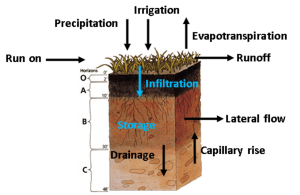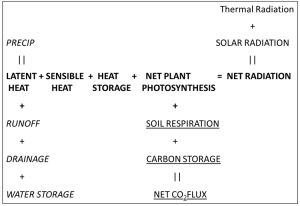Chapter 101.2 – Fluxes of Water and Energy in an Irrigated System

Revisiting Figure 1-2, the irrigation water requirement of the system can be quantified by using two basic principles:
These principles state that total mass (e.g. water) or total energy (e.g. radiation or heat) in an isolated system is conserved (i.e., remains constant).
Within the system, mass or energy can be converted into different forms but the total amount remains the same.
Therefore, these two principles can be used to quantify irrigation water requirements through simple accounting equations for water or heat.
In this short 2 mins video clip, Dr. Andales reviews these conservation principles in more detail.
Figure 1-3 below shows a conceptual diagram of these accounting equations and the connections between water, carbon, and energy budgets in a system such as the one shown in Fig. 1-2.
This system can be thought of as a soil-plant-atmosphere system, as water, carbon, and energy fluxes flow through these three main “compartments” of the system. We will discuss the application of conservation of mass and energy in irrigation management beginning in Lesson 2 and succeeding topics.

- Figure 1-3 shows that the water budget is linked to the energy budget through “latent heat,” which is the form of heat that causes evapotranspiration (ET).
- The carbon budget is linked to the energy budget through “net plant photosynthesis,” which is the portion of net radiation that is used by plants in photosynthesis (i.e., carbon assimilation for plant growth).
- The “net radiation” available in the system is the sum of solar radiation (or artificial light in the case of greenhouses) and thermal radiation (long-wave radiation emitted by objects).
We will define each of the terms shown in Fig. 1-3 in succeeding modules.
Wow…..that diagram can be a bit overwhelming, so Dr. Andales walks you through it in this 15 minutes video:
Review
Answer the following questions to help cement your understanding of the material.

Earn an industry recognized micro-credential at: CSU Upskill.
Conservation of mass - total mass of a substance (e.g., water) in an isolated system remains constant at a given point in time; the substance just exists in different forms (e.g., liquid, gas, etc.) or in different parts of the system.
Conservation of energy - total energy in an isolated system remains constant at a given point in time; the energy just exists in different forms (e.g., solar radiation, heat, etc.) or in different parts of the system.
Energy budget - also called energy balance; the sum of all forms of energy in a soil-plant-atmosphere system.
Water budget - the sum of water fluxes in a system; the total amount of water in an isolated system at any given time.
Evapotranspiration (ET) - water lost from the soil-plant system through transpiration from plant leaves and evaporation from the soil surface.
Carbon budget - the sum of different forms of carbon occurring in the soil-plant-atmosphere system.
Photosynthesis = carbon assimilation (absorption of CO2) for plant growth.
Net radiation = sum of solar radiation (or artificial light in the case of greenhouses) and thermal radiation (long-wave radiation emitted by objects).
